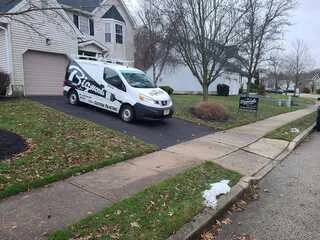When it comes to painting your home, using the right type of paint for each surface is more important than most people think. The paint you use for interior walls isn’t the same as what you’d want for a bathroom ceiling or the exterior of your house. At Bigwood’s Custom Painting, we’ve handled jobs of all sizes across New Jersey and know from experience that using the correct paint makes a huge difference—not just in how your home looks, but in how well it holds up over time.
If you’re wondering what kind of paint to use for walls, ceilings, or outdoor surfaces, this guide will help you make the right choice.
What’s the Best Paint for Interior Walls?
Interior wall paint should be durable, easy to clean, and look great for years. In living rooms, hallways, and bedrooms, latex-based paint with an eggshell or satin finish tends to work best. It has a soft sheen that’s easy to clean but not too shiny. For high-traffic areas like kids’ bedrooms, kitchens, and mudrooms, go for a more durable, scrubbable finish.
If you’re repainting over dark colors or patchy walls, using a primer first helps give you a smoother, more even finish. And if you want to improve indoor air quality, look for low-VOC or zero-VOC paints.
What Paint Should You Use on Ceilings?
Ceilings don’t get touched often, but they do reflect light and show every flaw. That’s why most painters use flat or matte paint. Flat ceiling paint doesn’t reflect light, so it hides imperfections better and gives ceilings a smooth, clean look.
Ceiling paint is usually thicker to prevent drips. In bathrooms or other humid areas, it’s best to use a mildew-resistant formula. This helps prevent peeling or spotting caused by moisture over time.
What Type of Paint Is Best for Exterior Surfaces?
Exterior paint needs to stand up to everything Mother Nature throws at it—rain, snow, sunlight, and temperature changes. For most homes, 100% acrylic latex exterior paint is the best choice. It sticks well, resists fading, and expands and contracts with your siding as the weather changes.
If your home has older wood siding, consider a breathable paint that allows moisture to escape. For brick or stucco exteriors, elastomeric coatings or masonry-specific paints work well and help seal small cracks.
A clean surface is critical for a lasting finish. Before painting, surfaces should be power washed and scraped if needed. In most cases, using a good primer on raw or stained areas helps the paint bond properly and last longer.
Do You Always Need Primer Before Painting?
Priming isn’t always necessary, but skipping it can lead to poor coverage and uneven color. For new drywall, previously unpainted surfaces, or spots that have been patched, a coat of primer helps the paint go on smoother and stay looking good longer.
On exterior surfaces, primer acts as a protective base coat. It seals the surface and helps prevent mildew, fading, and peeling.
How to Choose Paint That Lasts
Choosing paint isn’t just about color—it’s about performance. In each part of your home, the surface, conditions, and amount of wear all play a part. That’s why homeowners searching for “best paint for interior walls,” “what kind of paint for ceiling,” or “how to choose exterior house paint” will benefit from knowing how different products hold up in real life.
The right paint can save you money in the long run by reducing the need for frequent touch-ups or full repaints. It also helps protect your investment by shielding your walls and siding from damage.
Need Help Choosing Paint for Your Home in NJ?
At Bigwood’s Custom Painting, we don’t just show up with a brush and a can of paint. We take time to understand your space, surface conditions, and goals so we can recommend the best product for the job.
If you’re planning to repaint your home and want long-lasting results, reach out to our team. We’re happy to offer honest advice and professional service that gets it done right the first time. Let us help you protect and refresh your South Jersey home, one coat at a time.





